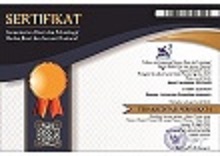MODEL KENYAMANAN TERMAL DENGAN MENGGUNAKAN STRUCTURAL EQUATION MODELING (SEM) PADA PONDOK PESANTREN DI WONOSOBO
Abstract
Abstract: The thermal comfort model still needs to be developed in order to find a thermal comfort model that is applicable to all regions. The problem of different thermal variables and human culture in different areas makes the thermal comfort model still needs to be researched. The use of different analytical methods will also make differences in the thermal comfort models found. Cold areas and differences in activity in a building become interesting for research. The purpose of the study was to analyze the thermal comfort in Islamic boarding schools in cold areas using the Structural Equation Modeling (SEM) method. The research uses quantitative methods by measuring thermal and personal variables, namely air temperature, globe temperature, air humidity, wind speed, human activities, and human clothing. Data analysis using graphs and using AMOS software to find the prediction model. The results showed that the wind speed in the room tends to be constant and the flow does not feel so it has a zero value. In the SEM analysis, the wind variable cannot be entered because an error result will be obtained. The model is made without wind variables so as to produce a mathematical equation: TSV = -0.418clothes + 2.796activity - 0.47air temperature - 0.539mrt + 0.178air humidity +0.686.
Keywords: thermal comfort model, SEM analysis, Islamic boarding school
Abstrak: Model kenyamanan termal masih perlu dikembangkan agar ditemukan model kenyamanan termal yang berlaku untuk semua wilayah. Permasalahan variabel termal yang berbeda-beda dan budaya manusia di suatu wilayah yang berbeda pula membuat model kenyamanan termal masih perlu diteliti. Penggunaan metode analisis yang berbeda juga akan membuat perbedaan model kenyamanan termal yang ditemukan. Wilayah dingin dan perbedaan aktivitas pada suatu bangunan menjadi menarik untuk dijadikan penelitian. Tujuan penelitian adalah menganalisa kenyamanan termal di pondok pesantren di daerah dingin dengan menggunakan metode Structural Equation Modelling (SEM). Penelitian menggunakan metode kuantitatif dengan melakukan pengukuran variabel termal dan personal yaitu suhu udara, suhu globe, kelembaban udara, kecepatan angin, aktivitas manusia dan pakaian manusia. Analisa data menggunakan grafik dan menggunakan software AMOS untuk menemukan model prediksinya. Hasil penelitian menunjukkan bahwa kecepatan angin di dalam ruangan cenderung tetap dan tidak terasa alirannya sehingga mempunyai nilai nol. Pada analisa dengan SEM, variabel angin tidak bisa dimasukkan karena akan didapat hasil error. Model dibuat tanpa variabel angin sehingga menghasilkan persamaan matematis : TSV = -0,418pakaian + 2,796aktivitas - 0,47suhu_udara - 0,539mrt + 0,178kelembaban_udara +0,686.
Kata Kunci: model kenyamanan termal, analisa SEM, pondok pesantrenFull Text:
PDFReferences
Bahari, M. N. (2020). THERMAL COMFORT INVESTIGATION ON HOLY MOSQUE Case Study : Lautze 2 Mosque Bandung. Journal of Architectural Researh and Education, 2(1), 82–89. https://doi.org/10.17509/jare.v2i1.24105
Daniel, L., Baker, E., & Williamson, T. (2019). Cold housing in mild-climate countries: A study of indoor environmental quality and comfort preferences in homes, Adelaide, Australia. Building and Environment, 151(December 2018), 207–218. https://doi.org/10.1016/j.buildenv.2019.01.037
Dwisusanto, Y. B., & Hermawan. (2020). The role and meaning of fireplace in Karangtengah Hamlet settlement, Banjarnegara: A study of the spatial pattern of pawon and kinship. ARTEKS : Jurnal Teknik Arsitektur, 5(3), 479–488. https://doi.org/10.30822/arteks.v5i3.609
Hermawan, Prianto, E., & Setyowati, E. (2018). Studi lapangan variabel iklim rumah vernakular pantai dan gunung dalam menciptakan kenyamanan termal adaptif. Jurnal Arsitektur ZONASI, 1(2), 96. https://doi.org/10.17509/jaz.v1i2.12467
Hermawan, Prijotomo, J., & Dwisusanto, Y. B. (2020). The Geni tradition as the center of the shelter for Plateau Settlements. Ecology, Environment and Conservation, 26(1), 34–38.
Hermawan, H., & Švajlenka, J. (2021). The connection between architectural elements and adaptive thermal comfort of tropical vernacular houses in mountain and beach locations. Energies, 14(21). https://doi.org/10.3390/en14217427
Hermawan, Prianto, E., & Setyowati, E. (2020). The comfort temperature for exposed stone houses and wooden houses in mountainous areas. Journal of Applied Science and Engineering, 23(4), 571–582. https://doi.org/10.6180/jase.202012_23(4).0001
Hermawan, Prianto, E., Setyowati, E., & Sunaryo. (2019). The thermal condition and comfort temperature of traditional residential houses located in mountainous tropical areas: An adaptive field study approach. International Journal on Advanced Science, Engineering and Information Technology, 9(6), 1833–1840. https://doi.org/10.18517/ijaseit.9.6.3560
Jafarpur, P., & Berardi, U. (2021). Effects of climate changes on building energy demand and thermal comfort in Canadian office buildings adopting different temperature setpoints,. Journal of Building Engineering, 42(102725).
Ma, N., Aviv, D., Guo, H., & Braham, W. W. (2021). Measuring the right factors: A review of variables and models for thermal comfort and indoor air quality. Renewable and Sustainable Energy Reviews, 135(August 2020), 110436. https://doi.org/10.1016/j.rser.2020.110436
Mujan, I., Anđelković, A. S., Munćan, V., Kljajić, M., & Ružić, D. (2019). Influence of indoor environmental quality on human health and productivity - A review. Journal of Cleaner Production, 217, 646–657. https://doi.org/10.1016/j.jclepro.2019.01.307
Rawal, R., Schweiker, M., Kazanci, O. B., Vardhan, V., Jin, Q., & Duanmu, L. (2020). Personal comfort systems: A review on comfort, energy, and economics. Energy and Buildings, 214. https://doi.org/10.1016/j.enbuild.2020.109858
Salcido, J. C., Raheem, A. A., & Issa, R. R. A. (2016). From simulation to monitoring: Evaluating the potential of mixed-mode ventilation (MMV) systems for integrating natural ventilation in office buildings through a comprehensive literature review. Energy and Buildings, 127, 1008–1018. https://doi.org/10.1016/j.enbuild.2016.06.054
Sihombing, R. P. (2019). Climatological Aspects in the Circulation of Sustainable Apartment. Journal of Architectural Research and Education, 1(2), 139. https://doi.org/10.17509/jare.v1i2.22305
Su, X., Wang, Z., Xu, Y., & Liu, N. (2020). Thermal comfort under asymmetric cold radiant environment at different exposure distances. Building and Environment, 178(February), 106961. https://doi.org/10.1016/j.buildenv.2020.106961
Vakalis, D., Touchie, M., Tzekova, E., MacLean, H. L., & Siegel, J. A. (2019). Indoor environmental quality perceptions of social housing residents. Building and Environment, 150(December 2018), 135–143. https://doi.org/10.1016/j.buildenv.2018.12.062
Wei, W., Wargocki, P., Zirngibl, J., Bendžalová, J., & Mandin, C. (2020). Review of parameters used to assess the quality of the indoor environment in Green Building certification schemes for offices and hotels. Energy and Buildings, 209. https://doi.org/10.1016/j.enbuild.2019.109683
Yang, B., Li, X., Liu, Y., Chen, L., Guo, R., Wang, F., & Yan, K. (2022). Comparison of models for predicting winter individual thermal comfort based on machine learning algorithms. Building and Environment, 215(March), 108970. https://doi.org/10.1016/j.buildenv.2022.108970
Yang, D., & Mak, C. M. (2020). Relationships between indoor environmental quality and environmental factors in university classrooms. Building and Environment, 186(September), 107331. https://doi.org/10.1016/j.buildenv.2020.107331
DOI: https://doi.org/10.17509/jaz.v5i3.50258
Refbacks
- There are currently no refbacks.
Copyright (c) 2022 Adinda Septi Hendriani, Hidayatus Sibyan, hermawan Hermawan

This work is licensed under a Creative Commons Attribution-ShareAlike 4.0 International License.






